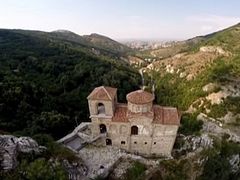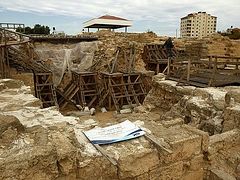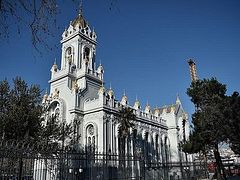Brussels; The Hague, May 23, 2018
The ancient Church of St. Kyriaki on the South Aegean Greek island of Naxos and a mosaic of the Transfiguration at Mt. Sinai’s 6th-century St. Catherine’s Monastery have been declared winners of the 2018 European Union Prize for Cultural Heritage / Europa Nostra Awards in the conservation category.
A Europa Nostra Award is one of the highest honors in the field of European heritage. The 29 winners from 17 countries were announced by Europa Nostra on May 15, being “recognized for their impressive accomplishments in conservation, research, dedicated service, and education, training and awareness-raising.”
“I warmly congratulate this year’s ‘heritage champions’… We are deeply impressed by the exceptional skills, creativity, commitment and generosity of so many heritage professionals, volunteers and supporters from all over Europe… Our Award winners are living proof that our cultural heritage is far more than the memory of our past; it is key to understanding our present and a resource for our future,” stated the renowned opera singer and Europa Nostra president Plácido Domingo.
Church of St. Kyriaki
St. Kyriaki’s is a true gem, featuring a unique set of wall paintings dating to the 8th or 9th century, during the times when the heresy of Iconoclasm ripped through the Church, leading to the destruction of countless precious icons. The final defeat of this heresy is celebrated every first Sunday of Lent, known as the Triumph of Orthodoxy.
The secluded, single-domed church was until recently accessible only by a footpath from the village of Apeiranthos. The church’s rural setting, while picturesque, led to years of neglect, and rainwater penetrating the roof inflicted severe damage on the structure of the walls and vaults and on the ancient wall paintings.
The well-preserved interior paintings, limited only to crosses, animals, and geometric and floral patterns, bear witness to their time of origin during the Iconoclastic controversy. Such paintings have been preserved in rare cases, and those of the Church of St. Kyriaki are the best preserved in the Cyclades islands.
The church caught the attention of the Swiss associations “J.-G. Eynard” of Geneva and “Amitiés gréco-suisses,” which began their conservation efforts in 1993. A voluntary association, with the sole purpose of saving the endangered house of God, was formed in 2004.
Thankfully, their efforts proved successful. “The conservation of Hagia Kyriaki succeeded in saving an endangered monument and its unique paintings, with meticulous effort to protect its authenticity and refrained from adding elements that would mask the passing of time and history,” according to Europa Nostra.
The St. Kyriaki project is being seen as a model for similar cases on Naxos Island, where dozens of ruined Byzantine churches demand such care and attention for their preservation.
Transfiguration mosaic at St. Catherine’s Monastery
The basilica at St. Catherine’s Monastery on Mt. Sinai suffered serious damage from an earthquake in 1995.
The monastery was founded by Byzantine emperor St. Justinian and completed before 565 AD. The basilica church retains most of its ancient decorations, including a glorious mosaic of the Transfiguration of the Lord in the apse, deemed a “a masterpiece of Eastern Christian art” by Europa Nostra.
With funding provided by the then-Emir of Qatar, Sheikh Hamad bin Khalifa Al Thani, and the Los Angeles-based Getty Conservation Institute, the monastery was able to cover the costs of the conservation work undertaken by the Rome-based Centro di Conservazione Archaeologica (CCA).
The monastery’s Athens-based Technical Bureau completed its restoration work on the apse walls in 2011, and the CCA completed its work on the mosaics in 2016, with support from the Egyptian Ministry of Antiquities. The official opening was held in 2017.
The jury highly commended “the European cooperation between the Italian conservation experts and the Greek Orthodox Monastery which was undertaken in close consultation with the Egyptian authorities and has resulted in high-quality conservation work on an element of such an outstanding World Heritage Site as the Monastery of Saint Catherine in Sinai. The documentation and quality of the work are exceptional.”
The conservators were able to identify the original materials and methods used in the construction of the mosaics, and in subsequent restorations, and thus were able to use materials compatible with the original mosaics. Each of the 20,000 replacement tiles were documented, with the information to be publicly posted online.
Europa Nostra also noted the unique scaffolding system, which allowed the conservation work to continue for years without interrupting the liturgical and spiritual life of the monastery. The judges praised “the strong scientific and religious collaboration in the most complex circumstances to create innovative technical solutions which made it possible to carry out conservation during religious services and in the most sacred part of the site.”
Winners of the Europa Nostra Awards will be honored at an award ceremony on June 22 in Berlin.
Follow us on Facebook!





